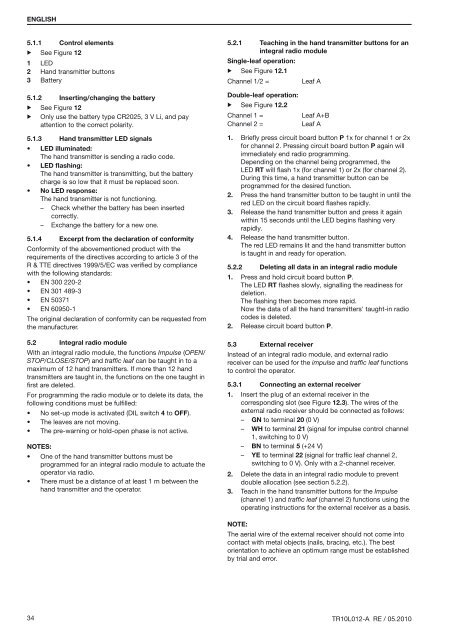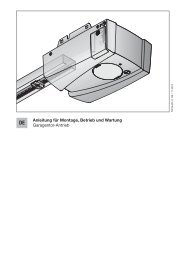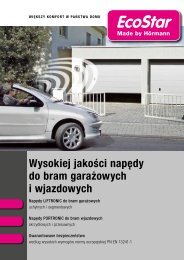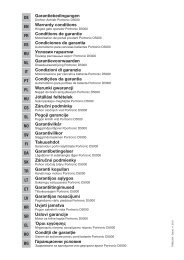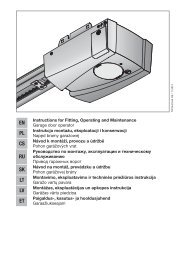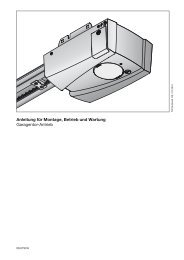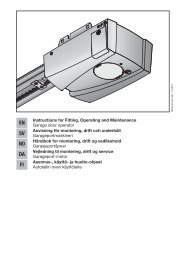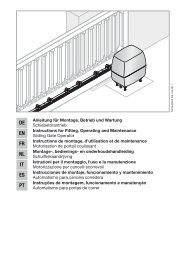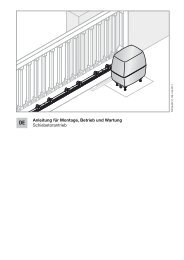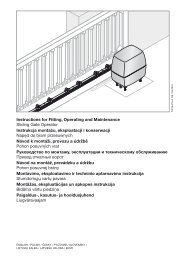Template BA B168xH238 - EcoStar
Template BA B168xH238 - EcoStar
Template BA B168xH238 - EcoStar
Create successful ePaper yourself
Turn your PDF publications into a flip-book with our unique Google optimized e-Paper software.
ENGLISH<br />
5.1.1<br />
▶ See Figure 12<br />
Control elements<br />
1 LED<br />
2 Hand transmitter buttons<br />
3 Battery<br />
5.1.2<br />
Inserting/changing the battery<br />
▶ See Figure 12<br />
▶ Only use the battery type CR2025, 3 V Li, and pay<br />
attention to the correct polarity.<br />
5.1.3<br />
Hand transmitter LED signals<br />
• LED illuminated:<br />
The hand transmitter is sending a radio code.<br />
• LED flashing:<br />
The hand transmitter is transmitting, but the battery<br />
charge is so low that it must be replaced soon.<br />
• No LED response:<br />
The hand transmitter is not functioning.<br />
– Check whether the battery has been inserted<br />
correctly.<br />
– Exchange the battery for a new one.<br />
5.1.4 Excerpt from the declaration of conformity<br />
Conformity of the abovementioned product with the<br />
requirements of the directives according to article 3 of the<br />
R & TTE directives 1999/5/EC was verified by compliance<br />
with the following standards:<br />
• EN 300 220-2<br />
• EN 301 489-3<br />
• EN 50371<br />
• EN 60950-1<br />
The original declaration of conformity can be requested from<br />
the manufacturer.<br />
5.2 Integral radio module<br />
With an integral radio module, the functions Impulse (OPEN/<br />
STOP/CLOSE/STOP) and traffic leaf can be taught in to a<br />
maximum of 12 hand transmitters. If more than 12 hand<br />
transmitters are taught in, the functions on the one taught in<br />
first are deleted.<br />
For programming the radio module or to delete its data, the<br />
following conditions must be fulfilled:<br />
• No set-up mode is activated (DIL switch 4 to OFF).<br />
• The leaves are not moving.<br />
• The pre-warning or hold-open phase is not active.<br />
Notes:<br />
• One of the hand transmitter buttons must be<br />
programmed for an integral radio module to actuate the<br />
operator via radio.<br />
• There must be a distance of at least 1 m between the<br />
hand transmitter and the operator.<br />
5.2.1 Teaching in the hand transmitter buttons for an<br />
integral radio module<br />
Single-leaf operation:<br />
▶ See Figure 12.1<br />
Channel 1/2 = Leaf A<br />
Double-leaf operation:<br />
▶ See Figure 12.2<br />
Channel 1 =<br />
Leaf A+B<br />
Channel 2 =<br />
Leaf A<br />
1. Briefly press circuit board button P 1x for channel 1 or 2x<br />
for channel 2. Pressing circuit board button P again will<br />
immediately end radio programming.<br />
Depending on the channel being programmed, the<br />
LED RT will flash 1x (for channel 1) or 2x (for channel 2).<br />
During this time, a hand transmitter button can be<br />
programmed for the desired function.<br />
2. Press the hand transmitter button to be taught in until the<br />
red LED on the circuit board flashes rapidly.<br />
3. Release the hand transmitter button and press it again<br />
within 15 seconds until the LED begins flashing very<br />
rapidly.<br />
4. Release the hand transmitter button.<br />
The red LED remains lit and the hand transmitter button<br />
is taught in and ready for operation.<br />
5.2.2 Deleting all data in an integral radio module<br />
1. Press and hold circuit board button P.<br />
The LED RT flashes slowly, signalling the readiness for<br />
deletion.<br />
The flashing then becomes more rapid.<br />
Now the data of all the hand transmitters' taught-in radio<br />
codes is deleted.<br />
2. Release circuit board button P.<br />
5.3 External receiver<br />
Instead of an integral radio module, and external radio<br />
receiver can be used for the impulse and traffic leaf functions<br />
to control the operator.<br />
5.3.1 Connecting an external receiver<br />
1. Insert the plug of an external receiver in the<br />
corresponding slot (see Figure 12.3). The wires of the<br />
external radio receiver should be connected as follows:<br />
– GN to terminal 20 (0 V)<br />
– WH to terminal 21 (signal for impulse control channel<br />
1, switching to 0 V)<br />
– BN to terminal 5 (+24 V)<br />
– YE to terminal 22 (signal for traffic leaf channel 2,<br />
switching to 0 V). Only with a 2-channel receiver.<br />
2. Delete the data in an integral radio module to prevent<br />
double allocation (see section 5.2.2).<br />
3. Teach in the hand transmitter buttons for the Impulse<br />
(channel 1) and traffic leaf (channel 2) functions using the<br />
operating instructions for the external receiver as a basis.<br />
Note:<br />
The aerial wire of the external receiver should not come into<br />
contact with metal objects (nails, bracing, etc.). The best<br />
orientation to achieve an optimum range must be established<br />
by trial and error.<br />
34 TR10L012-A RE / 05.2010


